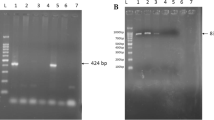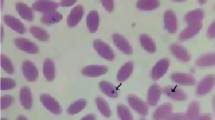Abstract
Molecular investigation of Anaplasmataceae species in the dromedary camel (Camelus dromedarius) is still lacking in Iran. In this study, the presence of Anaplasma and Ehrlichia species was investigated in a total of 100 camels in southern Iran. A total number of six camels (6.0 %) were infected by Candidatus Anaplasma camelii genetically related to Anaplasma platys. However, Ehrlichia spp. were not detected in any of the examined dromedary camels. Genetic analysis of the 16S rDNA gene of Iranian strain showed 100 % identity to Anaplasma strains previously reported from Tunisian and Saudi Arabian dromedary camels (accession nos. KM401907 and KF843825, respectively). Furthermore, phylogenetic studies based on the 16S rDNA gene provided more evidence for the circulation of a host-adapted Anaplasma species closely related to A. platys in dromedary camels. In this study, Hyalomma dromedarii were recovered from positive camels in studied regions. These findings highlight the role of this tick species as a potential vector for camel Anaplasmosis. This study describes the first molecular prevalence of Candidatus A. camelii in Iranian dromedary camels.



Similar content being viewed by others
References
Arraga-Alvarado CM, Qurollo BA, Parra OC, Berrueta MA, Hegarty BC, Breitschwerdt EB (2014) Molecular evidence of Anaplasma platys infection in two women from Venezuela. AmJTrop Med Hyg 91:1161–1165
Bastos AD, Mohammed OB, Bennett NC, Petevinos C, Alagaili AN (2015) Molecular detection of novel Anaplasmataceae closely related to Anaplasma platys and Ehrlichia canis in the dromedary camel (Camelus dromedarius). Vet Mic 179:310–314
Belkahia H, Said MB, Sayahi L, Alberti A, Messadi L (2015) Detection of novel strains genetically related to Anaplasma platys in Tunisian one-humped camels (Camelus dromedarius). J Infect Dev Ctries 9:1117–1125
Doudier B, Olano J, Parola P, Brouqui P (2010) Factors contributing to emergence of Ehrlichia and Anaplasma spp. as human pathogens. Vet Parasitol 167:149–154
Dumler JS, Barbet AF, Bekker CP, Dasch GA, Palmer GH, Ray SC, Rikihisa Y, Rurangirwa FR (2001) Reorganization of genera in the families Rickettsiaceae and Anaplasmataceae in the order Rickettsiales: unification of some species of Ehrlichia with Anaplasma, Cowdria with Ehrlichia and Ehrlichia with Neorickettsia, descriptions of six new species combinations and designation of Ehrlichia equi and 'HGE agent' as subjective synonyms of Ehrlichia phagocytophila. Int J Syst Evol Microbiol 51:2145–2165
Fard SRN, Fathi S, Asl EN, Nazhad HA, Kazeroni SS (2012) Hard ticks on one-humped camel (Camelus dromedarius) and their seasonal population dynamics in southeast, Iran. Trop Anim Health Prod 44:197–200
Gharbi M, Moussi N, Jedidi M, Mhadhbi M, Sassi L, Darghouth MA (2013) Population dynamics of ticks infesting the one-humped camel (Camelus dromedarius) in Central Tunisia. Ticks Tick Borne Dis 4:488–491
Harvey JW, Simpson CF, Gaskin JM (1987) Cyclic thrombocytopenia induced by a Rickettsi-like agent in dogs. J Infect Dis 137:182–188
Kontos VI, Papadopoulos O, French TW (1991) Natural and experimental canine infections with a Greek strain of Ehrlichia platys. Vet Clin Path 20:101–105
Li Y, Yang J, Chen Z, Qin G, Li Y, Li Q, Liu J, Liu Z, Guan G, Yin H, Luo J (2015) Anaplasma infection of Bactrian camels (Camelus bactrianus) and ticks in Xinjiang. China Parasit Vectors 8:1
Maggi RG, Mascarelli PE, Havenga LN, Naidoo V, Breitschwerdt ED (2013) Co-infection with Anaplasma platys, Bartonella henselae and Candidatus Mycoplasma haematoparvum in a veterinarian. Parasites Vect 6:103
McQuiston JH, McCall CL, Nicholson WL (2003) Ehrlichiosis and related infections. J Am Vet Med Assoc 223:1750–1756
Mentaberre G, Gutiérrez C, Rodríguez NF, Joseph S, González-Barrio D, Cabezón O, de la Fuente J, Gortazar C, Boadella M (2013) A transversal study on antibodies against selected pathogens in Dromedary camels in the Canary Islands, Spain. Vet Microbiol 167:468–473
Nicholson WL, Allen KE, McQuiston JH, Breitschwerdt EB, Little SE (2010) The increasing recognition of rickettsial pathogens in dogs and people. Trend Parasitol 26:205–212
Tamura K, Stecher G, Peterson D, Filipski A, Kumar S (2013) MEGA6: molecular evolutionary genetics analysis version 6.0. Mol Biol Evol 30:2725–2729
Walker AR, Bouattour A, Camicas JL, Estrada-Pena A, Horak IG, Latif AA, Pegram RG, Prestom PM (2013) Ticks of domestic animals in Africa: A guide to identification of species, Part 4: species of ticks. 2nd edn, Bioscience reports. pp 45–221
Weisburg WG, Barns SM, Pelletier DA, Lane DJ (1991) 16S ribosomal DNA amplification for phylogentic study. J Bacteriol 173:697–703
Wernery U, Kaaden OR (2002) Infectious diseases of camelids, 2nd edn. Blackwell Science, Berlin, pp. 23–373
Woldehiwet Z (2010) The natural history of Anaplasma phagocytophilum. Vet Parasitol 167:108–122
Ybañez AP, Perez ZO, Gabotero SR, Yandug RT, Kotaro M, Inokuma H (2012) First molecular detection of Ehrlichia canis and Anaplasma platys in ticks from dogs in Cebu, Philippines. Ticks Tick Borne Dis 3:288–293
Zeleke M, Bekele T (2004) Species of ticks on camels and their seasonal population dynamics in eastern Ethiopia. Trop Anim Health Prod 36:225–231
Author information
Authors and Affiliations
Corresponding author
Ethics declarations
Ethical approval
This experiment was performed under the approval of the State Committee on Animal Ethics, Shiraz University, Shiraz, Iran.
Conflict of interest
The authors declare that they have no conflict of interest.
Funding
This study was funded by Research Council of Shiraz University and School of Veterinary Medicine, Shiraz University (Grant No. 87-GR-VT-47).
Rights and permissions
About this article
Cite this article
Sharifiyazdi, H., Jafari, S., Ghane, M. et al. Molecular investigation of Anaplasma and Ehrlichia natural infections in the dromedary camel (Camelus dromedarius) in Iran. Comp Clin Pathol 26, 99–103 (2017). https://doi.org/10.1007/s00580-016-2350-x
Received:
Accepted:
Published:
Issue Date:
DOI: https://doi.org/10.1007/s00580-016-2350-x




